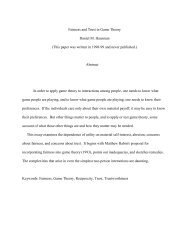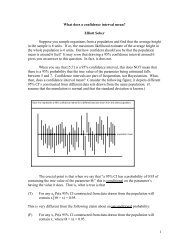Counterexamples to a Likelihood Theory of Evidence
Counterexamples to a Likelihood Theory of Evidence
Counterexamples to a Likelihood Theory of Evidence
Create successful ePaper yourself
Turn your PDF publications into a flip-book with our unique Google optimized e-Paper software.
while h 2says that the probability <strong>of</strong> H is almost 0, say .0000001. Let M1be the beambalance model conjoined with h1, while M2is the beam balance model conjoined withh2. The simple hypotheses, h 1&( θ = 17) and h2 &( θ = 21) , for example, can be codedin the parameters by writing θ1= 17 and θ2= 21, respectively. It is now clear that thelikelihood functions for M1and M2are different despite the fact that the likelihoodfunctions for θ are equivalent for the purpose <strong>of</strong> estimating values <strong>of</strong> θ. This helpsblock a simple-minded argument against the <strong>Likelihood</strong> Principle, which goes somethinglike this: We can tell from the <strong>to</strong>tal evidence that M2is false because all simplehypotheses in M2assign a probability <strong>of</strong> almost 0 <strong>to</strong> the outcome H. But the two modelsare likelihood equivalent because their likelihood functions differ only by a constant.Agreed! This argument is wrong.This much seems clear: Most Bayesians, if not all, think that in order <strong>to</strong> gaininformation about which <strong>of</strong> two models is correct, it is at least necessary for there besome difference in the likelihood functions <strong>of</strong> the models. For if the likelihoods functions<strong>of</strong> two models were exactly the same, the only way for the posterior probabilities <strong>to</strong> bedifferent would be for the priors <strong>to</strong> be different, but a difference in priors does not countas evidential discrimination. This is the assumption that I have referred <strong>to</strong> as the<strong>Likelihood</strong> <strong>Theory</strong> <strong>of</strong> <strong>Evidence</strong> (LTE).Preliminary ExamplesWhen a mass is hung on a spring, it oscillates for a period <strong>of</strong> time and comes <strong>to</strong> rest.After the system reaches an equilibrium state, the spring is stretched by a certain amount;let’s denote this variable by Y. To simplify the example, suppose that Y takes on adiscrete value 0 152, 2, 2, …, 2,2, because in-between positions are not stable. Maybe thisis because the motion <strong>of</strong> the device is constrained by a ball moving inside a lubricatedcylinder with a serrated surface (see Fig.2, right). The mass hung on the springconsists <strong>of</strong> a number <strong>of</strong> identical pellets(e.g., coins). This number is also anobserved quantity—denoted by X = 1, 2,3,…Conduct 2 trials <strong>of</strong> the experiment,and record the observations <strong>of</strong> (X, Y):Suppose they are (4,3.5) and (4,4.5).The data are represented by the soliddots in Fig. 2. Now consider thehypothesis A: Y = X + U, where U is aY7654321random error term that takes on values1 2 3 4 5 6−½ , or ½, each with probability ½.0XStrictly speaking, it’s a contradiction <strong>to</strong>say that Y = 3.5 and then Y = 4.5 . Weshould introduce a different set <strong>of</strong>variables for each trial <strong>of</strong> theFigure 2: Discrete data, Section 4. The solid dotsare points at which data is observed, while theopen circles are points at which no data isobserved.7




